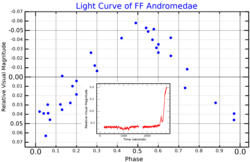 Two light curves for FF Andromedae are shown. The main plot shows the variation in brightness as the star rotates, and the inset plot shows a flare that occurred on 18 October 1991. Adapted from plots in Bopp et al. 1977 [1] and Peres et al. 1993. [2] | |
| Observation data Epoch J2000 Equinox J2000 | |
|---|---|
| Constellation | Andromeda |
| Right ascension | 00h 42m 48.24949s [3] |
| Declination | +35° 32′ 55.65804″ [3] |
| Apparent magnitude (V) | 10.428 variable [4] |
| Characteristics | |
| Spectral type | M1Ve+M1Ve [5] |
| Apparent magnitude (B) | 11.84 [6] |
| Apparent magnitude (V) | 10.428 [4] |
| Apparent magnitude (R) | 9.941 [4] |
| Apparent magnitude (I) | 8.8 [7] |
| Apparent magnitude (G) | 9.5526 [3] |
| Apparent magnitude (J) | 7.164 [8] |
| Apparent magnitude (H) | 6.506 [8] |
| Apparent magnitude (K) | 6.321 [8] |
| Variable type | BY Dra + Flare |
| Astrometry | |
| Radial velocity (Rv) | −0.47±0.90 [9] km/s |
| Proper motion (μ) | RA: 262.064±0.074 [3] mas/yr Dec.: 77.062±0.109 [3] mas/yr |
| Parallax (π) | 46.0337±0.0542 mas [3] |
| Distance | 70.85 ± 0.08 ly (21.72 ± 0.03 pc) |
| Orbit [10] | |
| Period (P) | 2.17 days |
| Inclination (i) | 60° |
| Details | |
| FF Andromedae A | |
| Mass | 0.55 [11] M☉ |
| Radius | 0.757 [11] R☉ |
| Temperature | 3,464 [11] K |
| Metallicity [Fe/H] | +0.101 [11] dex |
| Rotation | 2.170 days [12] |
| Rotational velocity (v sin i) | 7.8 [11] km/s |
| FF Andromedae B | |
| Mass | 0.55 [11] M☉ |
| Radius | 0.757 [11] R☉ |
| Temperature | 3,464 [11] K |
| Metallicity [Fe/H] | +0.101 [11] dex |
| Rotational velocity (v sin i) | 6.6 [11] km/s |
| Age | 55 [11] Myr |
| Other designations | |
| 2MASS J00424820+3532554, BD+34 106, HIP 3362, GJ 29.1, TYC 2283-26-1, NLTT 2314, WDS J00428+3533A | |
| Database references | |
| SIMBAD | data |
FF Andromedae (often abbreviated to FF And) is a spectroscopic binary in the constellation Andromeda. It has a typical apparent visual magnitude of 10.4, but undergoes flare events that can increase its brightness by about a magnitude.